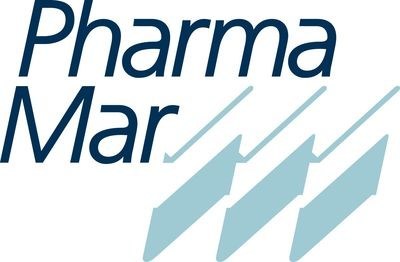Sylentis has reached the target of recruiting patients for its Phase III trial “HELIX” for the treatment of the signs and symptoms of dry eye disease
- Sylentis has reached the target of recruiting patients for its Phase III trial “HELIX” for the treatment of the signs and symptoms of dry eye disease
- PharmaMar estimate that the results of the trial will be available in the first four months of 2019
MADRID, Oct. 19, 2018 /PRNewswire/ -- Sylentis, PharmaMar Group (MCE: PHM), has announced today that it has reached its target of recruiting 300 patients for the Phase III trial “HELIX” [1] for the treatment of the signs and symptoms of dry eye disease.
PharmaMar estimate that the results of the trial will be available in the first four months of 2019.

The primary endpoint of this study is to evaluate the effect of tivanisiran, administrated in ophthalmic drops, on the signs and symptoms of patients with this pathology, for which therapeutic options are currently limited. The HELIX trial enrolled 329 patients which have been recruited in 39 centers in six European countries: Spain, Germany, Estonia, Portugal, Slovakia and Italy.
“Completing recruitment for the HELIX trial is an important milestone in the development of tivanisiran for the treatment of dry eye disease. We have confidence in our technology, which is new in its field, and we hope that tivanisiran can become an alternative for treating the millions of people who suffer from dry eye in the world,” says Ana Isabel Jiménez, COO of Sylentis.
Sylentis presented results from previous phase II study of tivanisiran during the Annual Congress of the Association for Research in Vision and Ophthalmology (ARVO), which was held from April 29 to May 3 in Honolulu, Hawaii. The poster presented, “Tivanisiran, a new treatment for Dry Eye Disease, that improved signs and symptoms in clinical trials,” showed the drug’s impact on inflammatory eye parameters, tear quality, and saw a reduction in eye pain associated with dry eye.
The mechanism of action of tivanisiran is based on RNA interference technology (RNAi), thus acting by blocking the synthesis of the transient receptor potential cation channel (TRPV1), involved in dry eye disease.
Tivanisiran, administered in the form of ophthalmic drops, is directed to the treatment of signs and symptoms of this pathology and its novel mechanism of action positions it as a potential treatment of dry eye disease.
About dry eye syndrome
This disease occurs when the eye does not produce tears correctly or when the tears do not have the necessary consistency and evaporate very quickly[2]. It especially affects populations in developed countries, where factors such as pollution, air conditioning, the use of contact lenses, refractive surgery operations or the continued use of computers are the main causes. The most noticeable symptoms of the pathology are burning, incessant itching, eye fatigue, dryness, blurred vision, sensation of a foreign body or pain[3], among others.
In Spain, one out of five visits to the ophthalmologist are motivated by this problem. In fact, more than five million people in Spain suffer from this condition, which represents between 10% and 20% of the population. The most common profile are mostly women over the age of 404 and practically 100% of the elderly. Globally, the number of people affected by dry eye is 344 million.
Learn more about the clinical trial: https://clinicaltrials.gov/ct2/show/NCT03108664?term=SYL1001&rank=2
Explanatory videos:
What is RNA interference? https://youtu.be/T21N_dPM0_k
Dry Eye Syndrome: https://youtu.be/R-h_4_Yyq2g
Legal warning
This press release does not constitute an offer to sell or the solicitation of an offer to buy securities, and shall not constitute an offer, solicitation or sale in any jurisdiction in which such offer, solicitation or sale would be unlawful prior to registration or qualification under the securities laws of that jurisdiction.
About PharmaMar
Headquartered in Madrid, PharmaMar is a biopharmaceutical company, focused on oncology and committed to research and development which takes its inspiration from the sea to discover molecules with antitumor activity. It is a company that seeks innovative products to provide healthcare professionals with new tools to treat cancer. Its commitment to patients and to research has made it one of the world leaders in the discovery of antitumor drugs of marine origin.
PharmaMar has a pipeline of drug candidates and a robust R&D oncology program. It develops and commercializes Yondelis® in Europe and has other clinical-stage programs under development for several types of solid cancers: lurbinectedin (PM1183), PM184 and PM14. With subsidiaries in Germany, Italy, France, Switzerland, Belgium, Austria and the United States. PharmaMar wholly owns other companies: GENOMICA, a molecular diagnostics company; Sylentis, dedicated to researching therapeutic applications of gene silencing (RNAi); and a chemical enterprise, Zelnova Zeltia. To learn more about PharmaMar, please visit us at www.pharmamar.com.
About Sylentis
Sylentis is a pharmaceutical company that develops innovative therapies using gene silencing or RNAi technologies. This technology allows the design of molecules capable of selectively inhibiting the synthesis of disease-causing proteins. Sylentis has developed numerous therapies based on this novel technology and currently has a solid program in ophthalmology with a candidate in a Phase III clinical trial: tivanisirán, for the treatment of dry eye1; and another in Phase II: bamosiran, for the treatment of glaucoma[4]. Sylentis also researches and develops other new products for the treatment of different ocular diseases such as ocular allergies and retinal diseases. For more information visit www.sylentis.com.
About tivanisirán (SYL1001)
SYL1001 is a drug based on RNAi that is administered as preservative-free eye drops; it selectively inhibits production of the transient receptor potential cation channel (TRPV1). These receptors are ion channels that mediate the transmission of ocular pain. SYL1001 is a small synthetic double-stranded RNA oligonucleotide (siRNA) with a novel and highly selective mechanism of action. Non-clinical studies conducted by Sylentis with SYL1001 have demonstrated it has high ability to inhibit this specific target and block the perception of ocular pain in animals6.
SYL1001 is a product undergoing development for the signs and symptoms related to with dry eye syndrome, and has potential to be developed for other pathologies that cause ocular pain (corneal lesions, refractive surgery, etc.) [5],[6],[7],[8]
About RNA interference (RNAi)
RNA interference (RNAi) is a natural cellular process that regulates the expression of certain genes, providing a role in innate defense and development in animal and plants. This process is used to specifically silence genetic transcripts that encode protein-causing diseases. The therapeutic application of targeted siRNAs is booming given the specificity of gene silencing for a particular protein in a given tissue and the lack of side effects. This new approach to drug discovery is a promising technology that is rapidly moving in the translational research space[9],[10].
- https://clinicaltrials.gov/ct2/show/NCT03108664?term=helix&rank=5 (Abril, 2018)
- https://nei.nih.gov/health/dryeye/dryeye
- The definition and classification of dry eye disease: report of the Definition and Classification Subcommittee of the International Dry Eye WorkShop (2007). Ocul Surf, 2007. 5(2): p. 75-92
- Moreno-Montañés J, Sádaba B, Ruz V, Gémez-Guiu A, Zarranz J, Gonzélez MV et al. Phase I Clinical Trial of SYL040012, A Small Interfering RNA Targeting β-Adrenergic Receptor 2, for Lowering Intraocular Pressure. Mol Ther. 2014, 22(1):226-32
- Benítez-Del Castillo JM, Protocol No.: SYL1001_IV. EUDRACT No: 2016-003903-79. A double-masked study of SYL1001 in patients with moderate to severe dry eye disease (DED). HELIX Study (Phase III). Version 1.1: December 14th, 2016. Sylentis SAU-Pharma Mar Group.
- Pañeda C, González V, Martínez T, Ruz V, Vargas B and Jiménez AI. RNAi based therapies for ocular conditions. In Proceedings of the 11th ISOPT,2014, 25-30, Medimond, Bologna, Italy
- Martínez-García C, Martínez T, Pañeda C, Gallego P, Jimenez AI, Merayo J. Differential expression and localization of transient receptor potential vanilloid 1 in rabbit and human eyes. Histol Histopathol, 2013, 28(11):1507-16
- Benítez-Del-Castillo JM, Moreno-Montañés J, Jiménez-Alfaro I, Muñoz-Negrete FJ, Turman K, Palumaa Martinez T, Gonzalez MV, Vargas B, Jimenez AI, Pañeda C. Preclinical Development of RNAi-Inducing Oligonucleotide Therapeutics for Eye Diseases. In RNA interference. ISBN: 978-953-51-4614-8. Ed. Intech. 2015et al. Safety and Efficacy Clinical Trials for SYL1001, a Novel Short Interfering for the treatment of Dry Eye Disease. Invest Ophthalmol Vis Sci. 2016 Nov 1;57(14):6447-6454
- Elbashir SM1, Harborth J, Lendeckel W, Yalcin A, Weber K, Tuschl T. Duplexes of 21-nucleotide RNAs mediate RNA interference in cultured mammalian cells. Nature. 2001 May 24;411(6836):494-8
- Soutschek J1, Akinc A, Bramlage B, Charisse K, Constien R, Donoghue M et al. Therapeutic silencing of an endogenous gene by systemic administration of modified siRNAs. Nature. 2004 Nov 11;432(7014):173-8
Media Contact:
Alfonso Ortín – Communications Director
aortin@pharmamar.com
Mobile: +34-609-493-127
Miguel Martínez-Cava – Digital Communication Manager
mmartinez-cava@pharmamar.com
Mobile: +34-606-597-464, Phone: +34 918466000
Investor Relations:
Phone: +34 914444500 / +34 902 10 19 00
Email: investorrelations@pharmamar.com
Or please visit our website at www.pharmamar.com
![]() View original content:http://www.prnewswire.com/news-releases/sylentis-pharmamar-group-announces-the-end-of-patient-recruitment-for-its-helix-trial-300734269.html
View original content:http://www.prnewswire.com/news-releases/sylentis-pharmamar-group-announces-the-end-of-patient-recruitment-for-its-helix-trial-300734269.html
SOURCE PharmaMar
Company Codes: Berlin:PMR, LSE:0RC6, OTC-PINK:PHMMF, SpanishCats:PHM, Dusseldorf:PMR, Frankfurt:PMR, OtherOTC:PHMMF, Stuttgart:PMR, XETRA:PMR




